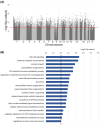DNA methylation in cord blood partially mediates the effects of prepregnancy BMI on early childhood offspring BMI
- PMID: 39663190
- PMCID: PMC11664306
- DOI: 10.1002/oby.24174
DNA methylation in cord blood partially mediates the effects of prepregnancy BMI on early childhood offspring BMI
Abstract
Objective: We investigated whether prepregnancy BMI (prePregBMI) in women with obesity was associated with differential DNA methylation (DNAm) in cord blood (CB) and whether DNAm may mediate the association of prePregBMI and early childhood BMI z score (BMIz).
Methods: From the Treatment of Obese Pregnant Women (TOP) study, 232 mother-child pairs were included. We conducted an epigenome-wide association study on prePregBMI and CB DNAm (450k array), followed by causal mediation analyses to test whether DNAm may mediate effects of prePregBMI on BMIz at age 36 months (BMIz36).
Results: DNAm at 5345 CpG sites annotated to 2842 genes, which were overrepresented in biological processes linked to carbohydrate metabolism and plasma lipoprotein particle clearance, was associated with prePregBMI (false discovery rate < 10%). Causal mediation analyses of 168 methylation sites associated with BMIz36 (p < 0.05) and overlapping with the 5345 prePregBMI-associated sites identified two sites on SYT7 and DEAF1, partially mediating the effect of prePregBMI on BMIz36 (p ≤ 0.01). After cross-validation, a methylation risk score including these two sites could predict the highest quartile of BMIz36 and fat mass (in grams) with area under the curve = 0.72 (95% CI: 0.58-0.85) and area under the curve = 0.71 (95% CI: 0.58-0.85), respectively.
Conclusions: CB DNAm at birth may partially mediate effects of prePregBMI on early childhood BMIz36, supporting its plausible role in influencing individual future obesity risk.
© 2024 The Author(s). Obesity published by Wiley Periodicals LLC on behalf of The Obesity Society.
Conflict of interest statement
The authors declared no conflicts of interest.
Figures





References
-
- World Health Organization . WHO European Regional Obesity Report 2022. WHO; 2022.
-
- Lawlor DA, Relton C, Sattar N, Nelson SM. Maternal adiposity—a determinant of perinatal and offspring outcomes? Nat Rev Endocrinol. 2012;8(11):679‐688. - PubMed
-
- Carlsen EM, Renault KM, Nørgaard K, et al. Newborn regional body composition is influenced by maternal obesity, gestational weight gain and the birthweight standard score. Acta Paediatr. 1992;103(9):939‐945. - PubMed
MeSH terms
Substances
Grants and funding
- Swedish Diabetes Foundation Danish Council for Strategic Research
- Hjärt-Lungfonden
- Strategic Research Area Exodiab
- European Foundation for the Study of Diabetes
- Novo Nordisk Foundation
- Fondo Gianesini Emma
- IRC15-0067/Swedish Foundation for Strategic Research
- Brødrene Hartmann Fonden
- Hvidovre Hospitals Forskningsfond
- Region Skåne
- Sygekassernes Helsefond
- Swedish Research Council
- 101080465/European Union's Horizon Europe Research and Innovation programme
- CoG-2015_681742_NASCENT/ERC_/European Research Council/International
LinkOut - more resources
Full Text Sources

